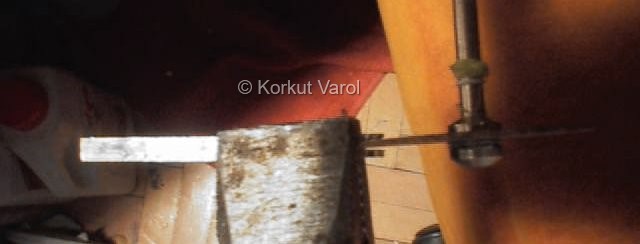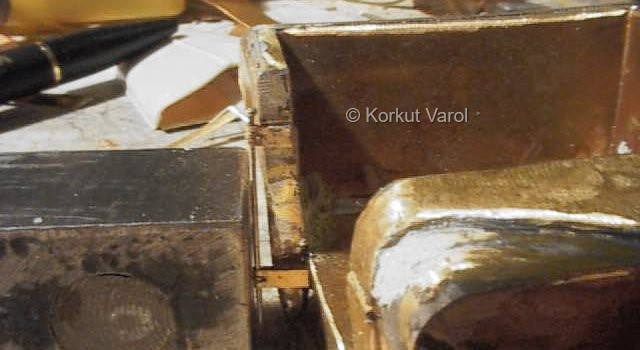|
CONSTRUCTION
STORY OF
SCRATCHBUILT
STREET ROD
|
 |
Building Period: 30 March 1999 - 30 June 1999
PART 7
THE DOOR HINGES
A break for the body. The front
grille
is duplicated by rubbing and pressing a 0.1 mm thick aluminium sheet on
the original part until all the contours are seen on the duplicate. The
grille rods are traced by a toothpick. Then the parts are taken apart
and
polyester putty (to be ground to better surface contour later) applied
at the back so that the part will have enough strength.

Now the story of the door hinges
begin.
A strip was cut from 0.2 mm brass sheet, with a width of 2.5 mm. One
side
was covered with a thin layer of solder. This will serve in holding the
metal together after the eye of the hinge is formed. The eye is formed
by squeezing the strip around a pin with the aid of pincers.

The eye is defined by pressing the soldering iron on the metal, thus melting the pre-soldered layer in between.

The mid part of the eye is ground by cutter tip of Dremel to make recess for the mating part of the hinge.

The finished mating parts are shown
here.
The second part is made in the same manner as described above, but with
the difference that the sides of the eye are ground to leave the center
part to fit in the recess of its mate.

The mating of the two parts of the
hinge
is shown here. The two leaves of the hinge will be cut to proper length
to fit in its place in the body. Two for each door, total of four
hinges
were made.

Preparing the hinges before
assembling
to the body. The working axes of the hinges are defined to be coaxial
by
using a common pin for assembly purposes. Later, the pin will be
replaced
by two separate ones.

The perpendicularity of the turning
axis
is checked before final glueing. 5-minute epoxy was used to fasten the
hinges to the body and doors. A precaution was taken with masking
tape
in case the glue would stick to the other leaf of the hinge. They will
stay in place until the door is glued also. One good thing with these
hinges
is that the doors can be removed in the process of preparation for
painting,
and painting itself.

The doors are put in place (after
final
assembly testing with the hinges) and 5-minute epoxy glue applied to
the
doors, at the points where the hinges are. The doors were secured to
the
body with masking tape until the glue was dry.

A close-up of the hinge while drying.
Note that the masking tape used here is the protective cover of a
double-sided
transparent sticking sheet. The paper is waxed, so it is impossible for
any glue to stick to it. Here it works! The excess part seen
on
the hinge was cut away with Dremel cutter tip.

 ........................
........................